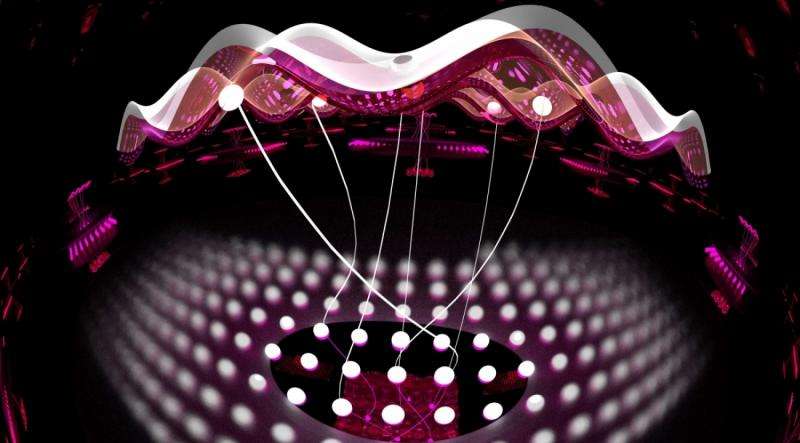Neural networks take on quantum entanglement

Machine learning, the field that's driving a revolution in artificial intelligence, has cemented its role in modern technology. Its tools and techniques have led to rapid improvements in everything from self-driving cars and speech recognition to the digital mastery of an ancient board game.
Now, physicists are beginning to use machine learning tools to tackle a different kind of problem, one at the heart of quantum physics. In a paper published recently in Physical Review X, researchers from JQI and the Condensed Matter Theory Center (CMTC) at the University of Maryland showed that certain neural networks—abstract webs that pass information from node to node like neurons in the brain—can succinctly describe wide swathes of quantum systems .
Dongling Deng, a JQI Postdoctoral Fellow who is a member of CMTC and the paper's first author, says that researchers who use computers to study quantum systems might benefit from the simple descriptions that neural networks provide. "If we want to numerically tackle some quantum problem," Deng says, "we first need to find an efficient representation."
On paper and, more importantly, on computers, physicists have many ways of representing quantum systems. Typically these representations comprise lists of numbers describing the likelihood that a system will be found in different quantum states. But it becomes difficult to extract properties or predictions from a digital description as the number of quantum particles grows, and the prevailing wisdom has been that entanglement—an exotic quantum connection between particles—plays a key role in thwarting simple representations.
The neural networks used by Deng and his collaborators—CMTC Director and JQI Fellow Sankar Das Sarma and Fudan University physicist and former JQI Postdoctoral Fellow Xiaopeng Li—can efficiently represent quantum systems that harbor lots of entanglement, a surprising improvement over prior methods.
What's more, the new results go beyond mere representation. "This research is unique in that it does not just provide an efficient representation of highly entangled quantum states," Das Sarma says. "It is a new way of solving intractable, interacting quantum many-body problems that uses machine learning tools to find exact solutions."
Neural networks and their accompanying learning techniques powered AlphaGo, the computer program that beat some of the world's best Go players last year (and the top player this year ). The news excited Deng, an avid fan of the board game. Last year, around the same time as AlphaGo's triumphs, a paper appeared that introduced the idea of using neural networks to represent quantum states , although it gave no indication of exactly how wide the tool's reach might be. "We immediately recognized that this should be a very important paper," Deng says, "so we put all our energy and time into studying the problem more."
The result was a more complete account of the capabilities of certain neural networks to represent quantum states. In particular, the team studied neural networks that use two distinct groups of neurons. The first group, called the visible neurons, represents real quantum particles, like atoms in an optical lattice or ions in a chain. To account for interactions between particles, the researchers employed a second group of neurons—the hidden neurons—which link up with visible neurons. These links capture the physical interactions between real particles, and as long as the number of connections stays relatively small, the neural network description remains simple.
Specifying a number for each connection and mathematically forgetting the hidden neurons can produce a compact representation of many interesting quantum states, including states with topological characteristics and some with surprising amounts of entanglement.
Beyond its potential as a tool in numerical simulations, the new framework allowed Deng and collaborators to prove some mathematical facts about the families of quantum states represented by neural networks. For instance, neural networks with only short-range interactions—those in which each hidden neuron is only connected to a small cluster of visible neurons—have a strict limit on their total entanglement. This technical result, known as an area law, is a research pursuit of many condensed matter physicists.
These neural networks can't capture everything, though. "They are a very restricted regime," Deng says, adding that they don't offer an efficient universal representation. If they did, they could be used to simulate a quantum computer with an ordinary computer, something physicists and computer scientists think is very unlikely. Still, the collection of states that they do represent efficiently, and the overlap of that collection with other representation methods, is an open problem that Deng says is ripe for further exploration.
More information: Dong-Ling Deng et al. Quantum Entanglement in Neural Network States, Physical Review X (2017). DOI: 10.1103/PhysRevX.7.021021
Journal information: Physical Review X
Provided by Joint Quantum Institute




















